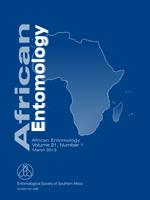Mango gall fly (Procontarinia matteiana Kieffer & Cecconi, 1906) is an orchard pest that infests flush leaves of mango, forming wart-like structures on the leaves. Serious outbreaks may result in reduced fruit yield. A natural parasite (Chrysonotomyia pulcherimma Kerrich, 1970) of the gall fly lays its eggs inside the gall and the larvae feed on the gall fly. Mango cultivars present varying susceptibilities to gall fly infestation, with cultivars ranging from completely resistant, highly susceptible to intermediate stages where pseudo-galls are formed. The latter cultivars are ovipositioned by the gall fly, but secondary metabolites within the leaves possibly halt the development, thereby preventing the development of true galls. Microscopy was used to identify characteristic features of the gall fly and its parasite inside the gall, to study the development of the insects and to distinguish them. Evidence was obtained that the use of insecticides curbs the development of the larvae. Tissue development within true and pseudo-galls was studied to provide insights into the role of secondary plant metabolites in arresting true gall formation. This study will contribute to a more holistic approach to pest management of mango.
How to translate text using browser tools
1 March 2013
Infestation of Mangifera indica by the Mango Gall Fly, Procontarinia matteiana, (Kieffer & Cecconi) (Diptera: Cecidomyiidae)
W.A. Augustyn,
W. du Plooy,
B.M. Botha,
E. van Wilpe
ACCESS THE FULL ARTICLE
It is not available for individual sale.
This article is only available to subscribers.
It is not available for individual sale.
It is not available for individual sale.

African Entomology
Vol. 21 • No. 1
March 2013
Vol. 21 • No. 1
March 2013
gall structures
mango gall fly
parasite
scanning electron microscopy
systemic insecticide




